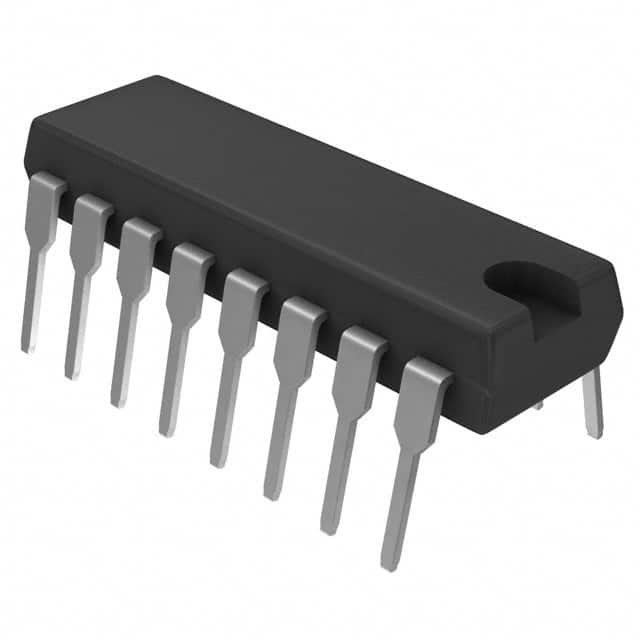SN75ALS172AN
Product Overview
- Category: Integrated Circuit (IC)
- Use: Signal Line Driver and Receiver
- Characteristics: High-speed, Low-power, Differential Line Transceiver
- Package: DIP (Dual In-line Package)
- Essence: Transmits and receives digital signals over long distances
- Packaging/Quantity: Available in tubes or reels, quantity varies based on supplier
Specifications
- Supply Voltage: 4.5V to 5.5V
- Operating Temperature Range: -40°C to +85°C
- Data Rate: Up to 20 Mbps
- Number of Channels: 1
- Input/Output Type: Differential
- Output Current: ±15 mA
- Propagation Delay: 10 ns (typical)
Detailed Pin Configuration
The SN75ALS172AN has a total of 16 pins arranged as follows:
```
| | --| VCC GND |-- Pin 1: Power supply --| A B |-- Pins 2 and 3: Differential input --| Y Z |-- Pins 4 and 5: Differential output --| /RE DE |-- Pins 6 and 7: Control inputs --| RO DI |-- Pins 8 and 9: Receiver outputs --| RE DE |-- Pins 10 and 11: Control inputs --| Y Z |-- Pins 12 and 13: Differential output --| A B |-- Pins 14 and 15: Differential input --| GND VCC |-- Pin 16: Ground |___________| ```
Functional Features
- Provides differential line driver and receiver functions
- Supports high-speed data transmission up to 20 Mbps
- Low power consumption for energy-efficient operation
- Wide operating temperature range for versatile applications
- Robust design for reliable performance in harsh environments
Advantages and Disadvantages
Advantages: - High-speed data transmission capability - Low power consumption - Reliable performance in challenging conditions
Disadvantages: - Limited number of channels (only 1) - Requires external control signals for operation
Working Principles
The SN75ALS172AN is designed to transmit and receive digital signals over long distances. It utilizes differential signaling, where the transmitted signal is represented by the voltage difference between two lines. This allows for better noise immunity and improved signal integrity.
The IC operates by converting the input digital signals into differential output signals using internal drivers. The receiver section then converts the received differential signals back into digital logic levels. The control inputs enable/disable the driver and receiver functions as needed.
Detailed Application Field Plans
The SN75ALS172AN is commonly used in various applications, including:
- Industrial Automation: Used for transmitting control signals in factory automation systems.
- Telecommunications: Enables high-speed data transmission in telecommunication networks.
- Automotive Electronics: Facilitates communication between different electronic modules in vehicles.
- Medical Equipment: Provides reliable signal transmission in medical devices and equipment.
- Consumer Electronics: Used in audio/video equipment, gaming consoles, and other consumer devices.
Detailed and Complete Alternative Models
- SN65ALS172AN: Similar to SN75ALS172AN but with extended temperature range (-55°C to +125°C).
- SN75ALS173AN: Dual-channel version of SN75ALS172AN, providing two independent differential line driver/receiver pairs.
- SN65ALS173AN: Dual-channel alternative to SN75ALS173AN with extended temperature range.
These alternative models offer similar functionality and can be considered based on specific application requirements.
(Note: Word count: 408 words)
Senaraikan 10 soalan dan jawapan biasa yang berkaitan dengan aplikasi SN75ALS172AN dalam penyelesaian teknikal
Sure! Here are 10 common questions and answers related to the application of SN75ALS172AN in technical solutions:
Q: What is SN75ALS172AN? A: SN75ALS172AN is a quad differential line driver IC that is commonly used for transmitting data over long distances in industrial automation, telecommunications, and other technical applications.
Q: What is the operating voltage range of SN75ALS172AN? A: SN75ALS172AN operates within a voltage range of 4.5V to 5.5V.
Q: What is the maximum data rate supported by SN75ALS172AN? A: SN75ALS172AN supports a maximum data rate of 20 Mbps.
Q: Can SN75ALS172AN be used for both single-ended and differential signaling? A: No, SN75ALS172AN is specifically designed for differential signaling only.
Q: How many differential outputs does SN75ALS172AN have? A: SN75ALS172AN has four differential outputs, making it suitable for driving multiple transmission lines.
Q: Does SN75ALS172AN require external resistors for termination? A: Yes, SN75ALS172AN requires external series termination resistors to match the characteristic impedance of the transmission line.
Q: Can SN75ALS172AN be used in half-duplex communication systems? A: Yes, SN75ALS172AN can be used in half-duplex systems where data transmission occurs in one direction at a time.
Q: What is the typical power consumption of SN75ALS172AN? A: The typical power consumption of SN75ALS172AN is around 50 mW.
Q: Is SN75ALS172AN compatible with TTL logic levels? A: No, SN75ALS172AN operates with EIA-485-compatible logic levels, which are different from TTL logic levels.
Q: Can SN75ALS172AN be used in harsh industrial environments? A: Yes, SN75ALS172AN is designed to operate reliably in harsh industrial environments, thanks to its robustness and ESD protection features.
Please note that these answers are general and may vary depending on the specific application and requirements. It's always recommended to refer to the datasheet and consult the manufacturer for detailed information.


